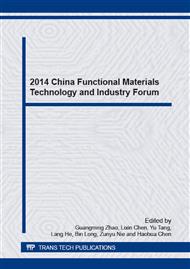[1]
N.F. Atta, A.M. Fekry and H.M. Hassaneen: Corrosion inhibition hydrogen evolution and antibacterial properties of newly synthesized organic inhibitors on 316L stainless steel alloy in acid medium. Hydrogen Energy. Vol. 36 (2011), pp.6462-6471.
DOI: 10.1016/j.ijhydene.2011.02.134
Google Scholar
[2]
M. Cecius and C.A. Jerome: Fully aqueous sustainable process for strongly adhering antimicrobial coating on stainless steel. Progress Organic in Coat. Vol. 70(2011), pp.220-223.
DOI: 10.1016/j.porgcoat.2010.09.025
Google Scholar
[3]
X.T. Le, G. Zeb, P. Jegou, etc. Electrografting of stainless steel by the diazonium salt of 4-aminobenzylphosphonic acid. Electrochemica Acta. Vol. 71(2012), pp.66-72.
DOI: 10.1016/j.electacta.2012.03.076
Google Scholar
[4]
A. Shahryari, S. Omanovic and J.A. Szpunar. Electrochemical formation of highly pitting resistant passive films on a biomedical grade 316LVM stainless steel surface. Materials Science & Engineering. Vol. 28(2008) No. 1, pp.94-106.
DOI: 10.1016/j.msec.2007.09.002
Google Scholar
[5]
M.C. Sin, Y.M. Sun and Y. Chang. Zwitterionic-based stainless steel with well-defined polysulfobetaine brushes for general bioadhesive control. Applied Materials & Interfaces. Vol. 6(2014), pp.861-873.
DOI: 10.1021/am4041256
Google Scholar
[6]
R.P. George, P. Muraleedharan, K.R. Sreekumari, etc. Influence of surface characteristics and microstructure on adhesion of bacterial cells onto a type 304 stainless steel. Vol. 19(2003) No. 1, pp.1-8.
DOI: 10.1080/08927010290031017
Google Scholar
[7]
H.M. Xu, W. Liu, L.X. Cao, etc. Preparation of porous TiO2/ZnO composite film and its photocathodic protection properties for 304 stainless steel. Applied Surface Science. Vol. 301(2014), pp.508-514.
DOI: 10.1016/j.apsusc.2014.02.114
Google Scholar
[8]
M.M. Sun, Z.Y. Chen, Y.Y. Bu, etc. Effect of ZnO on the corrosion of zinc, Q235 carbon steel and 304 stainless steel under white light illumination. Corrosion Science. Vol. 82(2014), pp.77-84.
DOI: 10.1016/j.corsci.2013.12.022
Google Scholar
[9]
S.N. Li, Q. Wang, T. Chen, etc. Study on cerium-doped nano-TiO2 coatings for corrosion protection of 316L stainless steel[J]. Nanoscale Research Letters. Vol. 7(2012) No. 1, p.227.
DOI: 10.1186/1556-276x-7-227
Google Scholar
[10]
H.Y. Li, Y.H. Ling, B. Jiang, etc. Anticorrosion behaviours of the TiO2/WO3 composite photoelectrodes for 304 stainless steel. High-Perpormance Ceramics IV. Vol. 336-338(2007), pp.2203-2206.
Google Scholar
[11]
D. Gopi, S. Ramya, D. Rajeswari, etc. Development of strontium and magnesium substituted porous hydroxyapatite/poly(3, 4-ethylenedioxythiophene) coating on surgical grade stainless steel and its bioactivity on osteoblast cells. Colloids and Surfaces B-Biointerfaces. Vol. 114(2014).
DOI: 10.1016/j.colsurfb.2013.10.011
Google Scholar
[12]
L.L. Xu, J. Jia, J.J. Feng, etc. Polymeric ionic liquid modified stainless steel wire as a novel fiber for solid-phase microextraction. Journal of Separation Science. Vol. 36(2013) No. 2, pp.369-375.
DOI: 10.1002/jssc.201200644
Google Scholar
[13]
A. Ganash. Effect of current density on the corrosion protection of poly(o-toluidine)-coated stainless steel. International Journal of Electrochemical Science. Vol. 9(2014) No. 7, pp.4000-4013.
DOI: 10.1016/s1452-3981(23)08068-9
Google Scholar
[14]
M. Dudukcu. The electrochemical synthesis of poly(o-phenylenediamine) on stainless steel and its corrosion protection ability in 3. 5% NaCl solution. Research on Chemical Intermediates. Vol. 39(2013) No. 8, pp.3641-3647.
DOI: 10.1007/s11164-012-0868-3
Google Scholar
[15]
G. Zhu, J. Hou, H. F. Zhu, etc. Electrochemical synthesis of poly (3, 4-ethylenedioxythiophene) on stainless steel and its corrosion inhibition performance. Journal of Coatings Technology and Research. Vol. 10(2013) No. 5, pp.659-668.
DOI: 10.1007/s11998-013-9482-6
Google Scholar
[16]
J. Q. Zhang, X. Peng, D. J. Young, etc. Nano-crystalline coating to improve cyclic oxidation resistance of 304 stainless steel. Surface & Coatings Technology. Vol. 217(2013), pp.162-171.
DOI: 10.1016/j.surfcoat.2012.12.007
Google Scholar
[17]
C. Johnson, R. Gemmen and N. Orlovskaya. Nano-structured self-assembled LaCrO3 thin film deposited by RF-magnetron sputtering on a stainless steel interconnect material. Composites Part B-Engineering. Vol. 35(2004) No. 2, pp.167-172.
DOI: 10.1016/j.compositesb.2003.08.004
Google Scholar
[18]
F. Yu, S.G. Chen, H.M. Li, etc. Application of self-assembled 6-aminohexanol layers for corrosion protection of 304 stainless steel surface. Thin Solid Films. Vol. 520(2012) No. 15, pp.4990-4995.
DOI: 10.1016/j.tsf.2012.03.006
Google Scholar
[19]
S.J. Yuan, S.O. Pehkonen, Y.P. Ting, etc. Inorganic-organic hybrid coatings on stainless steel by layer-by-layer deposition and surface-initiated atom-transfer-radical polymerization for combating biocorrosion. Applied Materials & Interfaces. Vol. 1(2009).
DOI: 10.1021/am800182d
Google Scholar
[20]
C.M. Ruan, B. Thomas, M. Sergio etc. Creation and characterization of n-alkylthiol and n-alkylamine self-assembled monolayers on 316L stainless steel. Thin Solid Films. Vol. 419(2002), pp.95-104.
DOI: 10.1016/s0040-6090(02)00730-7
Google Scholar
[21]
L. Li, V. Breedveld and D.W. Hess. Creation of superhydrophobic stainless steel surfaces by acid treatments and hydrophobic film deposition. Applied Materials & Interfaces. Vol. 4(2012), pp.4549-4556.
DOI: 10.1021/am301666c
Google Scholar
[22]
F. Wang, K. Mori and Y. Oishi. Electrochemical polymerization of 6-(N-allyl-1, 1, 2, 2-tetrahydroperfluorodecyl) amino-1, 3, 5-triazine-2, 4-dithiol monosodium on aluminum. Polymer Journal. Vol. 38(2006) No. 5, pp.484-489.
DOI: 10.1295/polymj.38.484
Google Scholar
[23]
M. Yamamoto, M. Suzuki, M. Tachikawa, etc. Film formation from mixed solution of 1, 3, 5-triazine-2, 4-dithiol and phosphate onto Au, Ag, and Cu substrates. Journal Physical Chemistry. Vol. 112(2008), pp.6914-6923.
DOI: 10.1021/jp711923t
Google Scholar
[24]
C.J. Weng, C.H. Chang, I.L. Lin, etc. Advanced anticorrosion coating materials prepared from fluoro-polyaniline-silica composites with synergistic effect of superhydrophobicity and redox catalytic capability. Surface & Coatings Technology. Vol. 207(2012).
DOI: 10.1016/j.surfcoat.2012.04.097
Google Scholar


